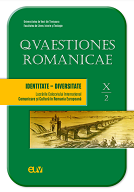L’olivo, il mandorlo e il ficodindia, impronte dell’identità siciliana in Pirandello
The Olive Tree, the Almond Tree and the Prickly Pear, Markers of the Sicilian Identity in Pirandello
Author(s): Gabriela E. DimaSubject(s): Identity of Collectives, Italian literature, Sociology of Literature
Published by: Universitatea de Vest din Timişoara
Keywords: Pirandello; Sicilian identity; olive tree; almond tree; prickly pear;
Summary/Abstract: More than other authors, Luigi Pirandello manages to conquer universality through an art deeply marked by his innermost identity, an identity that can be recognized even when his works are set in completely different locations. Perceptible in the reality of the places and in the thoughts of the characters, his native Sicily is never abandoned, even though it is not exalted either. Pirandello does not feel the need to affirm his sicilianity in his writings; instead he carries it inside and from there it reverberates throughout his work. Besides this inner level, Sicily is concretely present in many texts in which Pirandello dwells on specific details, from climate to traditions, from nature to mentalities. The comments of Sciascia, of Camilleri and of Pirandello's critics on the Saracen olive tree, a symbol of memory, a symbol of the soul, are well known. But there are other recurring elements of the island's botany, such as the almond tree or the prickly pear, whose role is fundamental to shape a universe that goes beyond metaphor. In Pirandello's texts we find many images of his primordial space: the shadow of the olive trees, Saracen or not, the almond trees in bloom, the prickly pear hedges. We therefore propose to analyze the way in which these elements define a geographical place but, above all, an identitarian one that marks the work and the life of the writer.
Journal: Quaestiones Romanicae
- Issue Year: X/2023
- Issue No: 2
- Page Range: 171-177
- Page Count: 7
- Language: Italian

